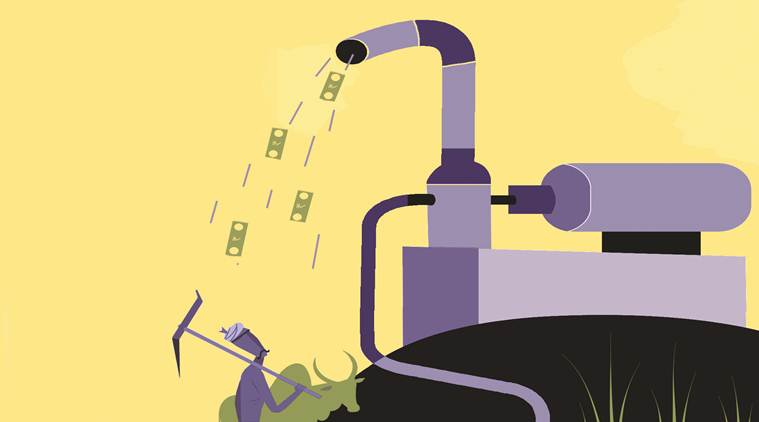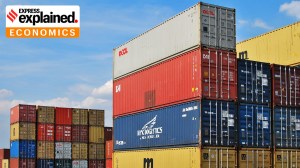- India
- International
Time has come to merge income support schemes with MGNREGA
The legal framework of the MGNREGA scheme does allow this on farms owned by people of SC/ST communities, and on the lands of marginal farmers.
 The first question to ask is: Who is the actual beneficiary of the income support schemes? (Illustration: C R Sasikumar)
The first question to ask is: Who is the actual beneficiary of the income support schemes? (Illustration: C R Sasikumar)
On May 12, Prime Minister Narendra Modi announced that his government’s relief-cum-stimulus package would be Rs 20 lakh crore, almost 10 per cent of India’s GDP. Most experts hailed the announcement. But when Finance Minister Nirmala Sitharaman unveiled the package, sector by sector, many wondered where the “new cash” was? It did not take much time to figure out that the additional relief and stimulus in the system is just about 1 per cent of the GDP — not 10 per cent. Much of the rest is directed towards increasing liquidity and deferring some loan payments, but not much additional cash.
The government has been stingy on cash payments presumably because its tax revenues are falling and it is hesitant to print more cash out of the fear of being downgraded by rating agencies. Even the worst affected migrant workers have not got much cash support. Farmers too have suffered losses because of the fall in farm prices, especially perishables. Onions and tomatoes, for example, are selling at around Rs 6/kg in India’s largest mandis like Lasalgaon, Chittoor and Kolar — this when the cost of production is about Rs 10/kg. Farmers growing flowers and grapes and milk producers face the same predicament. The government did promise Rs 2,000 per farm family from the PM-KISAN scheme, but this is only a reiteration of an earlier commitment.
In this context, the Chhattisgarh government deserves compliments for launching the Rajiv Gandhi Kisan Nyay Yojana (RGKNY), an income transfer scheme at Rs 10,000/acre for paddy farmers and Rs 13,000/acre for sugarcane farmers. The state’s chief minister, Bhupesh Baghel, has said that the scheme will be extended to farmers of other crops — in fact, to landless labourers as well. One will have to wait and see how the scheme is implemented, but on the face of it, RGKNY will help put money directly into the hands of farmers and poor agricultural labourers.
Baghel is not the first CM to implement a cash transfer scheme for farmers. In kharif 20’8-19, Telangana’s Chief Minister, K Chandrashekar Rao (KCR) announced a cash transfer scheme of Rs 4,000/acre, per season — this was raised to Rs 5,000/acre per season in kharif 2019-20. There is a live portal that gives the details of the scheme and its progress. In the rabi season of 2018-19, the Odisha government launched the KALIA scheme (Krushak Assistance for Livelihood and Income Augmentation) on a somewhat similar pattern. West Bengal’s Krishak Bandhu and Jharkhand’s Mukhya Mantri Krishi Aashirwad Yojana are the other income support schemes worth mentioning. These schemes were launched just before elections for obvious reasons. They also egged the Centre on to announcing the PM Kisan Yojana.
These income support policies are welcome. But it is high time to evaluate these schemes and refine or merge some of them so that they serve their purpose in an efficient and inclusive manner without much leakage.

The first question to ask is: Who is the actual beneficiary of the income support schemes? Are cash advances given to the owner farmer or the tenant farmer who actually tills the land? Ideally, the money should go to the real tiller. But in large parts of the country, there is no record of tenancy. The government data shows only 10 per cent tenancy in the country while several micro-level studies indicate that it could be anywhere between 25-30 per cent. In fact, in many regions like the Godavari belt, it could be even more than 50 per cent. It does not make much sense to put money into the accounts of absentee landlords. The best way would be to change the tenancy laws, and open up land lease markets, ensuring that the owner of the land has full rights to take his land back after the expiry of the lease period. The current law, favouring “land to the tiller”, is loaded against the owner. As a result, much of tenancy in the country remains oral.
In the absence of such legal changes in land lease laws, the only way forward is to fully inform the tiller that the owner has got income support and then appeal to the owner to pass on this benefit to the tiller — or adjust the land rent accordingly. Information and persuasion campaigns in radio and newspapers would increase the chances of the benefits being passed on to the real tillers — or at least help the tenants to bargain on the terms of tenancy.
The other issue is identifying the landless labourers working on farms. Majority of them are temporary and seasonal workers, and leaving the task of identification to panchayats and patwaris can open doors for large leakages and corruption. There have been talks in the past for synchronising MGNREGA with farm operations to contain the cost of farming as well as ensuring that those engaged in this employment guarantee scheme do useful and productive work. The legal framework of the MGNREGA scheme does allow this on farms owned by people of SC/ST communities, and on the lands of marginal farmers.
The time has come to think seriously about merging income support schemes, including the PM KISAN and state-level schemes, with the MGNREGA and price-subsidy schemes — food and fertiliser subsidies given by Centre and power subsidies given by state government. These schemes amount to Rs 5 lakh crore — that’s a good sum of money to start a basic income cover for poor households. Markets could then be left to operate freely. This approach can cover landless labourers, farmers, and poor consumers — these categories overlap.
Let there be an expert group to look closely into the functioning of each one of these schemes and create an umbrella scheme to take care of the poor and the needy. Would the Modi government move towards direct cash transfers?
The writer is Infosys Chair Professor for Agriculture at ICRIER
40 Years Ago
EXPRESS OPINION
More Explained
Apr 18: Latest News
- 01
- 02
- 03
- 04
- 05









































